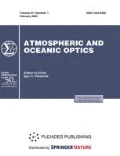Abstract
Field measurements of the concentrations of oxygenated organics in urban air and in forest were carried out. The results were used to test the model of atmospheric transformation of biogenic compounds. The simulation showed that condensable compounds of several classes are formed: hydroperoxides, peroxides, alkylperoxynitrates and nitrites, peracids. Their aerosol-generating potential was evaluated on the basis of the calculated steady-state concentrations of the direct precursors of aerosol phase. It was discovered that the main precursors of the nuclei of solid phase are hydroperoxides and peracids. The reason of their efficiency is their photolysis with the formation of oxygenated free radicals, which initiate gas-to-particle conversion through polymerization of unsaturated compounds via the free radical mechanism.


Similar content being viewed by others
REFERENCES
J. H. Seinfeld, Atmospheric Chemistry and Physics of Air Pollution (John Wiley & Sons, New York, 2005).
M. Kanakidou, J. H. Seinfeld, S. N. Pandis, I. Barnes, F. J. Dentener, and M. C. Facchini, R. van Dingenen, B. Ervens, A. Nenes, C. J. Nielsen, E. Swietlicki, J. P. Putaud, Y. Balkanski, S. Fuzzi, J. Horth, G. K. Moortgat, R. Winterhalter, C. E. L. Myhre, K. Tsigaridis, E. Vignati, E. G. Stephanou, and J. Wilson, “Organic aerosol and global climate modelling: A review,” Atmos. Chem. Phys. Discuss. 4, 5855–6024 (2004).
J. F. Hamilton, P. J. Webb, A. C. Lewis, J. R. Hopkins, S. Smith, and P. Davy, “Partially oxidised organic components in urban aerosol using GCXGC-TOF/MS,” Atmos. Chem. Phys. 4, 1279–1290 (2004).
L. Xing, J. L. Bao, Zh. Wang, F. Zhang, and D. G. Truhlar, “Degradation of carbonyl hydroperoxides in the atmosphere and in combustion,” J. Am. Chem. Soc. 139 (44), 15821–15835 (2017).
Y. Li, Zh. Chen, L. Huang, and D. Huang, “Organic peroxides’ gas–particle partitioning and rapid heterogeneous decomposition on secondary organic aerosol,” Atmos. Chem. Phys. 16, 1837–1848 (2016).
G. G. Dultseva, S. N. Dubtsov, F. N. Dultsev, T. V. Kobzeva, and D. V. Nekrasov, “Analysis of the surface functional groups of organic nanoparticles formed in furfural vapour photonucleation using a rupture event scanning technique,” Anal. Meth. 9, 5348–5355 (2017). https://doi.org/10.1039/c7ay01437f
F. N. Dultsev, I. A. Mik, S. N. Dubtsov, and G. G. Dultseva, “Identification of the functional groups on the surface of nanoparticles formed in photonucleation of aldehydes generated during forest fire events,” Proc. SPIE—Int. Soc. Opt. Eng. 9292 (2014). https://doi.org/10.1117/12.2075567
S. N. Dubtsov, G. G. Dul’tseva, M. E. Plokhotnichenko, P. V. Koshlyakov, and T. V. Kobzeva, “Investigation of furfural photolysis and photochemical aerosol formation kinetics,” Opt. Atmos. Okeana 30 (6), 476–480 (2017). https://doi.org/10.15372/AOO20170605
A. V. Keiko, NICK (Numerical Instrument for Chemical Kinetics). Version 2.2 (Melentiev Energy System Institute SB RAS, Irkutsk, 1996) [in Russian].
NIST Chemical Kinetics Database. Standard Reference Data. Gaithersburg, MD 20899.
V. N. Makarov, “Ingress of carbon with ions of organic carboxylic acids (formate, acetate, and oxalate) in the snow cover of frozen landscapes,” Opt. Atmos. Okeana 32 (2), 151–155 (2019).
W. J. McKillip, “Chemistry of furan polymers,” in Adhesives from Renewable Resources (American Chemistry Society, 1989), p. 117–138.
Funding
The work was carried out with support from the Russian Foundation for Basic Research and Novosibirsk Region within the research Project no. 19-43-540 009.
Author information
Authors and Affiliations
Corresponding authors
Ethics declarations
Authors declare no conflict of interests.
Rights and permissions
About this article
Cite this article
Dultseva, G.G., Nemova, E.F., Dubtsov, S.N. et al. Aerosol Generating Potential of the Products of Atmospheric Photooxidation of Biogenic Organic Compounds. Atmos Ocean Opt 33, 545–548 (2020). https://doi.org/10.1134/S1024856020050073
Received:
Revised:
Accepted:
Published:
Issue Date:
DOI: https://doi.org/10.1134/S1024856020050073




